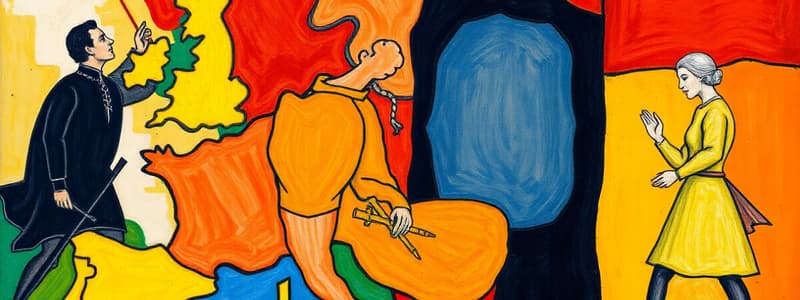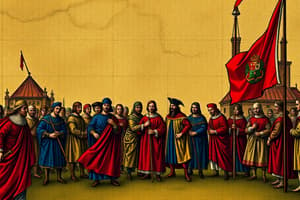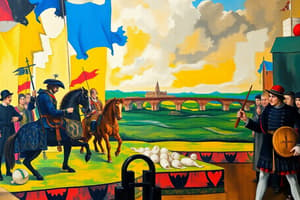Podcast
Questions and Answers
Which treaty marked the beginning of the modern state system in Europe?
Which treaty marked the beginning of the modern state system in Europe?
- Treaty of Versailles
- Treaty of Westphalia (correct)
- Treaty of Aix-la-Chapelle
- Treaty of Tordesillas
Maria Theresa was able to regain Silesia from Frederick the Great through the Treaty of Aix-la-Chapelle.
Maria Theresa was able to regain Silesia from Frederick the Great through the Treaty of Aix-la-Chapelle.
False (B)
What was the main reason that central European states developed more slowly than those in Western Europe?
What was the main reason that central European states developed more slowly than those in Western Europe?
The landowning aristocracy in central Europe passed laws restricting the ability of serfs to gain freedom and move to cities.
The Hohenzollerns transformed __________ into a rigidly controlled, highly militarized society by offering the Junkers exclusive rights to be officers in its army.
The Hohenzollerns transformed __________ into a rigidly controlled, highly militarized society by offering the Junkers exclusive rights to be officers in its army.
Match the figures with their respective actions or policies:
Match the figures with their respective actions or policies:
Which of the following best describes Frederick the Great's view of the role of a ruler?
Which of the following best describes Frederick the Great's view of the role of a ruler?
The Polish nobility strengthened the power of the Polish king by granting him a large income, law courts, and a standing army.
The Polish nobility strengthened the power of the Polish king by granting him a large income, law courts, and a standing army.
What was the significance of the diplomatic revolution that preceded the Seven Years' War?
What was the significance of the diplomatic revolution that preceded the Seven Years' War?
The Thirty Years' War severely damaged __________'s economy and delayed its unification as a state until the 1800s.
The Thirty Years' War severely damaged __________'s economy and delayed its unification as a state until the 1800s.
What was the primary consequence of the War of the Austrian Succession for Prussia?
What was the primary consequence of the War of the Austrian Succession for Prussia?
Cardinal Richelieu and Cardinal Mazarin supported the Hapsburgs during the Thirty Years’ War due to their shared Catholic faith.
Cardinal Richelieu and Cardinal Mazarin supported the Hapsburgs during the Thirty Years’ War due to their shared Catholic faith.
What steps did the Austrian Hapsburgs take to consolidate power and become absolute monarchs?
What steps did the Austrian Hapsburgs take to consolidate power and become absolute monarchs?
Frederick William I secured the cooperation of the Junkers by granting them the exclusive right to be __________ in his army, thus integrating them into the state's power structure.
Frederick William I secured the cooperation of the Junkers by granting them the exclusive right to be __________ in his army, thus integrating them into the state's power structure.
Which of the following was NOT a consequence of the Peace of Westphalia?
Which of the following was NOT a consequence of the Peace of Westphalia?
The Seven Years’ War resulted in significant territorial changes in Europe.
The Seven Years’ War resulted in significant territorial changes in Europe.
Flashcards
Thirty Years’ War
Thirty Years’ War
A series of conflicts in Europe from 1618 to 1648, initially sparked by religious tensions in the Holy Roman Empire but evolving into a broader struggle for political power.
Peace of Westphalia
Peace of Westphalia
The 1648 treaty that ended the Thirty Years’ War, marking a turning point in European history by weakening the Hapsburgs, strengthening France, and establishing a system of independent states.
Modern State System
Modern State System
A system where each state is recognized as having equal rights and sovereignty, contributing to a balance of power and diplomacy.
Serfdom in Central Europe
Serfdom in Central Europe
Signup and view all the flashcards
Hapsburg Consolidation
Hapsburg Consolidation
Signup and view all the flashcards
Pragmatic Sanction
Pragmatic Sanction
Signup and view all the flashcards
Rise of Prussia
Rise of Prussia
Signup and view all the flashcards
Frederick William, the Great Elector
Frederick William, the Great Elector
Signup and view all the flashcards
Junkers
Junkers
Signup and view all the flashcards
Frederick the Great
Frederick the Great
Signup and view all the flashcards
War of the Austrian Succession
War of the Austrian Succession
Signup and view all the flashcards
Seven Years' War
Seven Years' War
Signup and view all the flashcards
Maria Theresa's Infant
Maria Theresa's Infant
Signup and view all the flashcards
Silesia
Silesia
Signup and view all the flashcards
Study Notes
Thirty Years' War (1618-1648)
- Began when the Protestant Bohemian challenged Catholic Hapsburg ruler, Ferdinand II.
- German Protestants looked to Sweden's Gustavus Adolphus for help, who drove Hapsburg armies out of northern Germany.
- Gustavus Adolphus died in battle in 1632.
- France, under Cardinal Richelieu and Cardinal Mazarin, joined the German and Swedish Protestants against the Hapsburgs in 1635.
- The population of Germany dropped from 20 million to about 16 million.
- Trade, agriculture, and the German economy were ruined, delaying German unification until the 1800s.
Peace of Westphalia (1648)
- Weakened the Hapsburg states of Spain and Austria.
- Strengthened France by awarding it German territory.
- Made German princes independent of the Holy Roman emperor.
- Ended religious wars in Europe.
- Introduced a new method of peace negotiation where all participants meet to settle the problems of a war and decide the terms of peace.
- Recognized Europe as a group of equal, independent states, marking the beginning of the modern state system.
Central Europe in the Mid-1600s
- Major powers included the kingdom of Poland, the Holy Roman Empire, and the Ottoman Empire, none of which were strong.
- Landowning aristocracy in central Europe passed laws restricting the ability of serfs to gain freedom and move to cities.
- Polish nobility elected the Polish king and limited his power, preventing the formation of a unified state.
- The Holy Roman Empire was weakened by the Thirty Years’ War and could not command the obedience of the German states.
Austria Grows Stronger
- The Austrian Hapsburgs reconquered Bohemia, wiped out Protestantism, and created a new Czech nobility loyal to them.
- Centralized the government and created a standing army.
- Retook Hungary from the Ottoman Empire by 1699.
- Charles VI had difficulty ruling due to the diverse population within its borders: Czechs, Hungarians, Italians, Croatians, and Germans.
- Charles VI persuaded European leaders to recognize his eldest daughter, Maria Theresa, as his heir.
Prussia Challenges Austria
- Like Austria, Prussia rose to power in the late 1600s under the ruling family, the Hohenzollerns.
- In 1640, Frederick William, the Great Elector, inherited the title of elector of Brandenburg and built a strong army.
- The Great Elector and his descendants moved toward absolute monarchy by creating a standing army and introducing permanent taxation.
- Prussia’s landowning nobility, the Junkers, cooperated with the king in exchange for the exclusive right to be officers in his army.
- Prussia became a rigidly controlled, highly militarized society under Frederick William I.
Frederick the Great (Frederick II)
- Softened some of his father’s laws, encouraged religious toleration and legal reform.
- Believed that a ruler should be like a father to his people.
Maria Theresa
- Decreased the power of the nobility and limited the amount of labor that nobles could force peasants to do.
War of the Austrian Succession (1740)
- Frederick II (the Great) of Prussia wanted the Austrian land of Silesia, which bordered Prussia.
- Frederick underestimated Maria Theresa’s strength and sent his army to occupy Silesia.
- Maria Theresa asked the Hungarian nobles for aid, gained an army, and allied with Great Britain.
- Maria Theresa lost Silesia in the Treaty of Aix-la-Chapelle in 1748.
- Prussia became a major European power with the acquisition of Silesia.
The Seven Years’ War (1756-1763)
- Maria Theresa allied with France, leading Frederick to sign a treaty with Britain.
- Austria, France, Russia, and others were allied against Britain and Prussia.
- Frederick attacked Saxony, an Austrian ally, involving every great European power in the war.
- Fought in Europe, India, and North America.
- The war did not change the territorial situation in Europe.
- Britain gained sole economic domination of India, setting the stage for further British expansion in India in the 1800s.
Studying That Suits You
Use AI to generate personalized quizzes and flashcards to suit your learning preferences.




